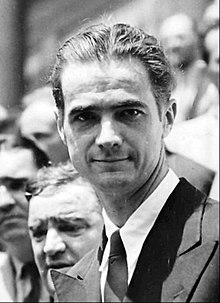 | |
| Founded | 1953 |
|---|---|
| Founder | Howard Hughes |
| Focus | Biological and Medical research and Science Education |
| Location | |
| Coordinates | 38°59′55″N 77°4′47″WCoordinates: 38°59′55″N 77°4′47″W |
| Method | Laboratories, Funding |
Key people
|
|
Revenue (2017)
| US$2.38 billion |
| Expenses (2017) | US$936.5 million |
| Endowment | US$22.6 billion |
| Website | hhmi.org |
The Howard Hughes Medical Institute (HHMI) is an American non-profit medical research organization based in Chevy Chase, Maryland. It was founded by the American businessman Howard Hughes in 1953. It is one of the largest private funding organizations for biological and medical research in the United States. HHMI spends about $1 million per HHMI Investigator per year, which amounts to annual investment in biomedical research of about $825 million.
The institute has an endowment of $22.6 billion, making it the second-wealthiest philanthropic organization in the United States and the second-best endowed medical research foundation in the world. HHMI is the former owner of the Hughes Aircraft Company - an American aerospace firm which was divested to various firms over time.
History
Howard Hughes, businessman, investor, pilot, film director, philanthropist, and founder of the institute.
The institute was formed with the goal of basic research including
trying to understand, in Hughes's words, "the genesis of life itself."
Despite its principles, in the early days it was generally viewed as a
tax haven for Hughes's huge personal fortune. Hughes was HHMI's sole
trustee and he transferred his stock of Hughes Aircraft
to the institute, in effect turning the large defense contractor into a
tax-exempt charity. For many years the Institute grappled with
maintaining its non-profit status; the Internal Revenue Service
challenged its "charitable" status which made it tax exempt. Partly in
response to such claims, starting in the late 1950s it began funding 47
investigators doing research at eight different institutions; however,
it remained a modest enterprise for several decades.
The institute was initially located in Miami, Florida, in 1953. Hughes's internist, Verne Mason, who treated Hughes after his 1946 plane crash, was chairman of the institute's medical advisory committee.
By 1975, Hughes was sole trustee of the Howard Hughes Medical
Institute, which in turn owned all the stock of the Hughes Aircraft
Company. In 1969, Representative Wright Patman
"complained that the Hughes foundation was a tax‐evasion device,"
noting that the institute spent only $5.7 million for its operations
between 1954 and 1961, a period during which Hughes Aircraft accumulated
$76.9 million in profits. By 1975, it had also avoided certain
stipulations of the 1969 reform act for charitable institutions due to
legal filings by Hughes to change its operational status, with his
objections going directly to the White House.
The institute moved to Coconut Grove, Florida, in the mid-1970s and then to Bethesda, Maryland, in 1976. In 1993 the institute moved to its headquarters in Chevy Chase, Maryland.
It was not until after Hughes's death in 1976 that the
institute's profile increased from an annual budget of $4 million in
1975 to $15 million in 1978 and prior to Hughes Aircraft sale the number
had peaked to $200 million per year. At the time of the sale Hughes
Aircraft employed 75,000 people and vast amounts of money from the
approximate annual revenue of $6 billion were put into Hughes Aircraft
internal research and development rather than the medical institute.
Most of the money for the medical institute came from the operations at
Ground System Group responsible for providing Air Defense Systems to
NATO, Pacific Rim, and the USA. In this period it focused its mission on
genetics, immunology, and molecular biology.
Since Hughes died without a will as the sole trustee of the HHMI, the
institute was involved in lengthy court proceedings to determine whether
it would benefit from Hughes's fortune. In April 1984, a court
appointed new trustees for the institute's holdings.
In January 1985 the trustees announced they would sell Hughes Aircraft
by private sale or public stock offering. On June 5, 1985 General Motors
(GM) was announced as the winner of a secretive five-month, sealed-bid
auction. The purchase was completed on December 20, 1985, for an
estimated $5.2 billion, $2.7 billion in cash and the rest in 50 million
shares of GM Class H stock. The proceeds caused the institute to grow
dramatically.
HHMI completed the building of a new research campus in Ashburn, Virginia called Janelia Research Campus in October 2006. It is modeled after AT&T's Bell Labs
and the Medical Research Council's Laboratory of Molecular Biology.
With a main laboratory building nearly 1,000 feet (300 m) long, it
contains 760,000 square feet (71,000 m2) of enclosed space, used primarily for research. The campus also features apartments for visiting researchers.
In 2007, HHMI and the publisher Elsevier announced they have
established an agreement to make author manuscripts of HHMI research
articles published in Elsevier and Cell Press journals publicly
available six months following final publication. The agreement takes
effect for articles published after September 1, 2007. In 2008, the
Trustees of the Howard Hughes Medical Institute selected Robert Tjian
as the new president of HHMI. In 2009, HHMI awarded fifty researchers,
as part of the HHMI Early Career Scientist Competition. In 2016, the
HHMI Trustees selected Erin K. O'Shea, a previous Vice President and Chief Scientific Officer at the institute, the new president of HHMI.
In 2014, the institute created a new round of its primary award
competition, for a total of $150 million in award money from 2015 to
2012. The institute is adding another campus in 2019.


